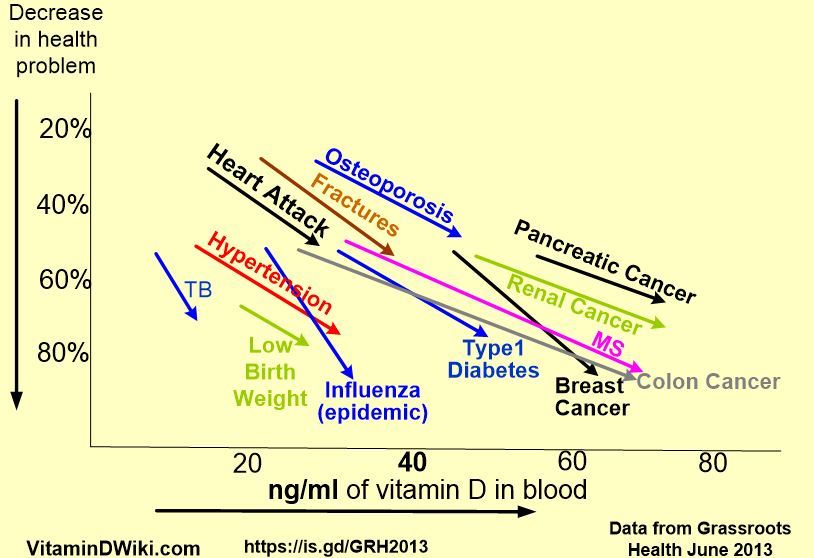Different amounts of vitamin D needed to prevent different diseases
Does Vitamin D Sufficiency Equate to a Single Serum 25-Hydroxyvitamin D Level or Are Different Levels Required for Non-Skeletal Diseases?
Nutrients 2013, 5(12), 5127-5139; doi:10.3390/nu5125127 (doi registration under processing)
Simon Spedding 1,spedding@adam.com.au, Simon Vanlint 2 Howard Morris 1,3and Robert Scragg 4
1 Division of Health Sciences, University of South Australia, Adelaide, SA 5000, Australia
2 Discipline of General Practice, School of Population Health, University of Adelaide, Adelaide, SA 5005, Australia
3 SA Pathology, PO Box 14, Rundle Mall, Adelaide, SA 5000, Australia
4 School of Population Health, Faculty of Medical and Health Sciences, The University of Auckland, Private Bag 92019, Auckland 1142, New Zealand
Received: 28 October 2013; in revised form: 27 November 2013 / Accepted: 28 November 2013 / Published: 16 December 2013
Objective: Clarify the concept of vitamin D sufficiency, the relationship between efficacy and vitamin D status and the role of Vitamin D supplementation in the management of non-skeletal diseases. We outline reasons for anticipating different serum vitamin D levels are required for different diseases.
Method: Review the literature for evidence of efficacy of supplementation and minimum effective 25-hydroxyvitamin D (25-OHD) levels in non-skeletal disease.
Results: Evidence of efficacy of vitamin supplementation is graded according to levels of evidence.
Minimum effective serum 25-OHD levels are lower for
skeletal disease, e.g., rickets (25 nmol/L), osteoporosis and fractures (50 nmol/L), than for
premature mortality (75 nmol/L) or non-skeletal diseases, e.g., depression (75 nmol/L), diabetes and cardiovascular disease (80 nmol/L),
falls and respiratory infections (95 nmol/L) and
cancer (100 nmol/L).
Conclusions: Evidence for the efficacy of vitamin D supplementation at serum 25-OHD levels ranging from 25 to 100 nmol/L has been obtained from trials with vitamin D interventions that change vitamin D status by increasing serum 25-OHD to a level consistent with sufficiency for that disease. This evidence supports the hypothesis that just as vitamin D metabolism is tissue dependent, so the serum levels of 25-OHD signifying deficiency or sufficiency are disease dependent.
Summary of study and some links to other VitaminDWiki pages
| Premature mortality | Level 1 (Systematic Review) | 75 nmol | 30 ng |
| Falls prevention | Level 1 (Systematic Review) | 95 nmol | 38 ng |
| Cancer prevention | Level 2 (RCT) | 100 nmol | 40 ng |
| Respiratory infection prevention | Level 2 (RCT) | 95 nmol | 38 ng |
| Diabetes prevention | Level 2 (RCT) | 80 nmol | 32 ng |
| Depression treatment | Level 2 (RCT) | 75 nmol | 30 ng |
| Musculoskeletal pain management | Level 2 (RCT) | ||
| Musculoskeletal strength | Level 3-1 (Pseudo RCT) | ||
| Dental disease | Level 3-2 (Study with Controls) | > 84nmol | > 37 ng |
| Cardiovascular disease | Level 3-2 (Study with Controls) | 80 nmol | 32 ng |
| Health service utilisation | Level 3-2 (Study with Controls) |
Australian National Health and Medical Research Council Evidence Hierarchy
1 Systematic review of Level II studies
2 Randomised controlled trial,
3-1 Pseudo-randomised controlled trial
3-2 Comparative study with concurrent controls:
- non-randomised, experimental trial,cohort study, case-control study, or interrupted time series with a control group
- 3-3A comparative study without concurrent controls:
- historical control study, or two or more single arm study, Interrupted time series without a parallel control group
4 Case series with either post-test or pre-test/post-test outcomes
PDF is attached at the bottom of this page
Comment by VitaminDWiki
There is a lot of evidence that the higher the vitamin D levels, the less occurrence of a particular disease as well of fewer of all diseases.
The study on this page just shows the detectable beginnings of disease prevention due to vitamin D
A nice summary of the prevention evidence is in the following chart
There are also many studies which prove that vitamin D TREATS diseases.
See also VitaminDWiki
Click on following chart for details of increasing vitamin D llevels to deal with different diseases

Proof that Vitamin D Works has the following summary
{include}
